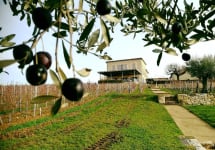Tour Saint Christophe 2022
-
James
Suckling -
Jeb
Dunnuck - Decanter
-
Robert
Parker



Product Details
Your Rating
Somm Note
Winemaker Notes
Blend: 80% Merlot, 20% Cabernet Franc
Professional Ratings
-
James Suckling
A very good year for Tour Saint Christophe, showing great depth and flavor despite high alcohol. Abundant dark minerals, fresh blackberries, black olives and a hint of cocoa powder. Pretty full-bodied and firm with crunchy, reactive tannins and a long and flavorful finish. Lots of density here.
-
Jeb Dunnuck
Spice-laden red and black fruits, leafy tobacco, savory flowers, and new leather notes all shine in the 2022 Château Tour Saint Christophe, another brilliant wine from this team. I love its complexity, and it's medium to full-bodied on the palate, with fine tannins, a layered, elegant mouthfeel, beautifully integrated oak, and a great finish. Based on 80% Merlot and 20% Cabernet Franc.
-
Decanter
Gorgeously scented on the nose, smooth, round and focused with purity and persistence. Tannins are so fine, really sculpting this wine, with a clear bite and almost strict tang to the overall structure giving a sense of tension. I like the terroir aspect, the saltiness but still with juicy richness. Less ample than Bellefonte but more precise.
Barrel Sample: 94 -
Robert Parker's Wine Advocate
This first vintage under the denomination of Grand Cru Classé, the 2022 Tour Saint Christophe is excellent, offering up aromas of spices, cassis, dark wild berries, orange peel and licorice mingled with delicate oaky notes. Medium to full-bodied, satiny and concentrated, it's layered and textured and framed by powdery, velvety tannins enhanced by a racy, pure, fresh finish. It should gain raciness with some time in the cellar.Rating :93+
Other Vintages
2024-
James
Suckling -
Robert
Parker - Vinous
-
James
Suckling -
Jeb
Dunnuck - Decanter
-
Robert
Parker - Vinous
- Vinous
-
James
Suckling -
Robert
Parker -
Jeb
Dunnuck - Decanter
-
James
Suckling - Decanter
- Vinous
-
Jeb
Dunnuck -
Robert
Parker
-
James
Suckling -
Jeb
Dunnuck -
Robert
Parker - Decanter
-
Jeb
Dunnuck -
James
Suckling -
Robert
Parker
-
James
Suckling -
Robert
Parker -
Jeb
Dunnuck -
Wine
Spectator
-
James
Suckling -
Jeb
Dunnuck -
Wine
Enthusiast -
Robert
Parker
-
James
Suckling -
Robert
Parker
-
James
Suckling -
Robert
Parker

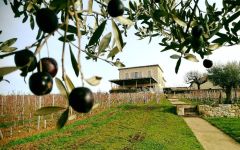
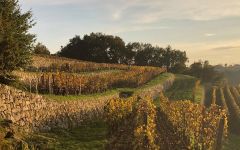
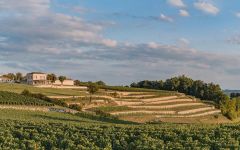
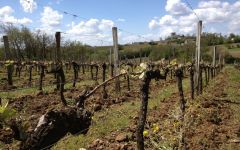
The Chateau overlooks beautiful dry stone terraces several hundred years old on a chalky-clay terroir. The vineyard is planted on this plateau where it has optimal sunlight and perfect natural drainage. The average age of the vines are thirty years old, they flourish and reach perfection in a limestone clay soil enhanced with sedimentary fragments of flint and chalk. It's this secret alchemy which makes the quality of our 'terroir'.
Aware of the richness of the legacy of the past and to preserve it, they undertook to restore Chateau Tour Saint Christophe. The objective was to revive the vineyard terraces with the disassembling and the reconstruction of this dry stone equipment as it had been built in the 18th century. About 1.5 km of dry-stone terraces have been renovated by re-shaping each stone by hand. A titanic work to preserve the original appearance of these unique terraces in Saint-Emilion.

One of the world’s most classic and popular styles of red wine, Bordeaux-inspired blends have spread from their homeland in France to nearly every corner of the New World. Typically based on either Cabernet Sauvignon or Merlot and supported by Cabernet Franc, Malbec and Petit Verdot, the best of these are densely hued, fragrant, full of fruit and boast a structure that begs for cellar time. Somm Secret—Blends from Bordeaux are generally earthier compared to those from the New World, which tend to be fruit-dominant.

Marked by its historic fortified village—perhaps the prettiest in all of Bordeaux, the St-Émilion appellation, along with its neighboring village of Pomerol, are leaders in quality on the Right Bank of Bordeaux. These Merlot-dominant red wines (complemented by various amounts of Cabernet Franc and/or Cabernet Sauvignon) remain some of the most admired and collected wines of the world.
St-Émilion has the longest history in wine production in Bordeaux—longer than the Left Bank—dating back to an 8th century monk named Saint Émilion who became a hermit in one of the many limestone caves scattered throughout the area.
Today St-Émilion is made up of hundreds of independent farmers dedicated to the same thing: growing Merlot and Cabernet Franc (and tiny amounts of Cabernet Sauvignon). While always roughly the same blend, the wines of St-Émilion vary considerably depending on the soil upon which they are grown—and the soils do vary considerably throughout the region.
The chateaux with the highest classification (Premier Grand Cru Classés) are on gravel-rich soils or steep, clay-limestone hillsides. There are only four given the highest rank, called Premier Grand Cru Classés A (Chateau Cheval Blanc, Ausone, Angélus, Pavie) and 14 are Premier Grand Cru Classés B. Much of the rest of the vineyards in the appellation are on flatter land where the soils are a mix of gravel, sand and alluvial matter.
Great wines from St-Émilion will be deep in color, and might have characteristics of blackberry liqueur, black raspberry, licorice, chocolate, grilled meat, earth or truffles. They will be bold, layered and lush.
